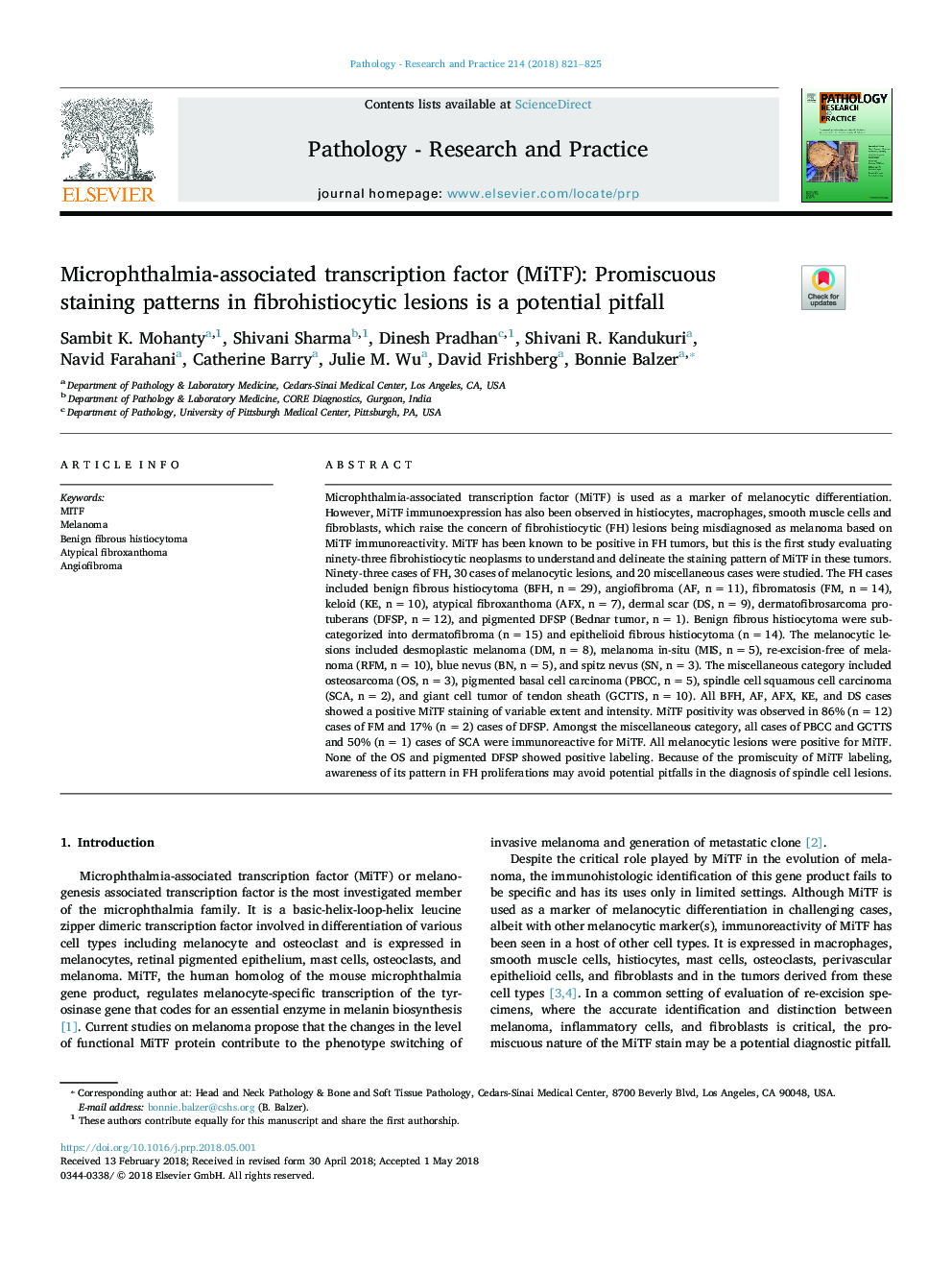| کد مقاله | کد نشریه | سال انتشار | مقاله انگلیسی | نسخه تمام متن |
|---|---|---|---|---|
| 8457973 | 1548864 | 2018 | 5 صفحه PDF | دانلود رایگان |
عنوان انگلیسی مقاله ISI
Microphthalmia-associated transcription factor (MiTF): Promiscuous staining patterns in fibrohistiocytic lesions is a potential pitfall
دانلود مقاله + سفارش ترجمه
دانلود مقاله ISI انگلیسی
رایگان برای ایرانیان
کلمات کلیدی
موضوعات مرتبط
علوم زیستی و بیوفناوری
بیوشیمی، ژنتیک و زیست شناسی مولکولی
تحقیقات سرطان
پیش نمایش صفحه اول مقاله

چکیده انگلیسی
Microphthalmia-associated transcription factor (MiTF) is used as a marker of melanocytic differentiation. However, MiTF immunoexpression has also been observed in histiocytes, macrophages, smooth muscle cells and fibroblasts, which raise the concern of fibrohistiocytic (FH) lesions being misdiagnosed as melanoma based on MiTF immunoreactivity. MiTF has been known to be positive in FH tumors, but this is the first study evaluating ninety-three fibrohistiocytic neoplasms to understand and delineate the staining pattern of MiTF in these tumors. Ninety-three cases of FH, 30 cases of melanocytic lesions, and 20 miscellaneous cases were studied. The FH cases included benign fibrous histiocytoma (BFH, nâ¯=â¯29), angiofibroma (AF, nâ¯=â¯11), fibromatosis (FM, nâ¯=â¯14), keloid (KE, nâ¯=â¯10), atypical fibroxanthoma (AFX, nâ¯=â¯7), dermal scar (DS, nâ¯=â¯9), dermatofibrosarcoma protuberans (DFSP, nâ¯=â¯12), and pigmented DFSP (Bednar tumor, nâ¯=â¯1). Benign fibrous histiocytoma were sub-categorized into dermatofibroma (nâ¯=â¯15) and epithelioid fibrous histiocytoma (nâ¯=â¯14). The melanocytic lesions included desmoplastic melanoma (DM, nâ¯=â¯8), melanoma in-situ (MIS, nâ¯=â¯5), re-excision-free of melanoma (RFM, nâ¯=â¯10), blue nevus (BN, nâ¯=â¯5), and spitz nevus (SN, nâ¯=â¯3). The miscellaneous category included osteosarcoma (OS, nâ¯=â¯3), pigmented basal cell carcinoma (PBCC, nâ¯=â¯5), spindle cell squamous cell carcinoma (SCA, nâ¯=â¯2), and giant cell tumor of tendon sheath (GCTTS, nâ¯=â¯10). All BFH, AF, AFX, KE, and DS cases showed a positive MiTF staining of variable extent and intensity. MiTF positivity was observed in 86% (nâ¯=â¯12) cases of FM and 17% (nâ¯=â¯2) cases of DFSP. Amongst the miscellaneous category, all cases of PBCC and GCTTS and 50% (nâ¯=â¯1) cases of SCA were immunoreactive for MiTF. All melanocytic lesions were positive for MiTF. None of the OS and pigmented DFSP showed positive labeling. Because of the promiscuity of MiTF labeling, awareness of its pattern in FH proliferations may avoid potential pitfalls in the diagnosis of spindle cell lesions.
ناشر
Database: Elsevier - ScienceDirect (ساینس دایرکت)
Journal: Pathology - Research and Practice - Volume 214, Issue 6, June 2018, Pages 821-825
Journal: Pathology - Research and Practice - Volume 214, Issue 6, June 2018, Pages 821-825
نویسندگان
Sambit K. Mohanty, Shivani Sharma, Dinesh Pradhan, Shivani R. Kandukuri, Navid Farahani, Catherine Barry, Julie M. Wu, David Frishberg, Bonnie Balzer,